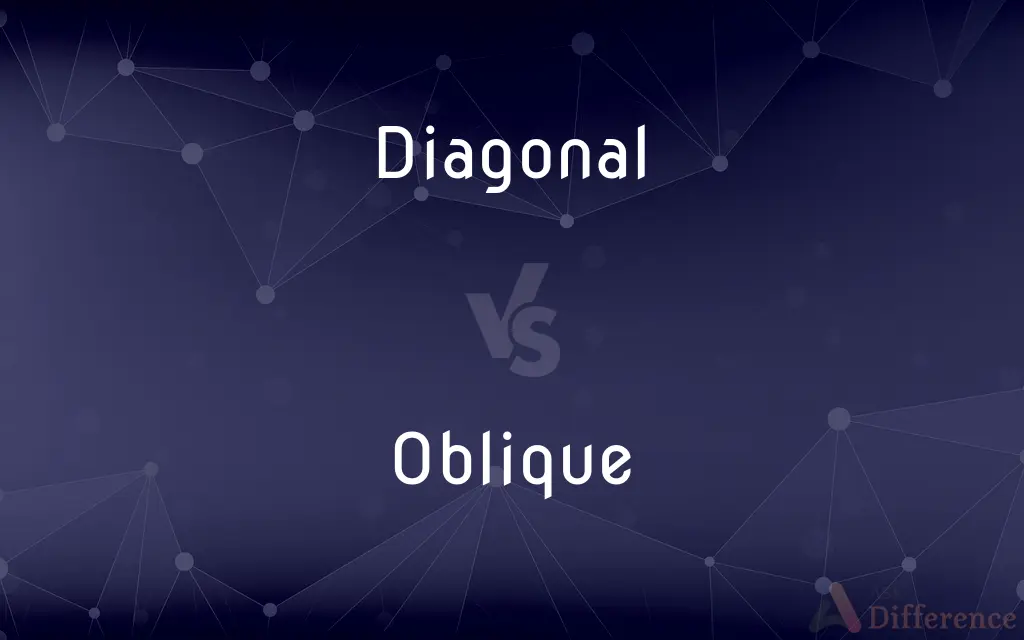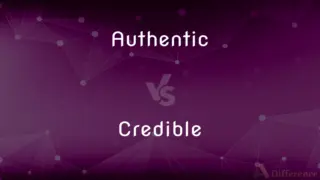Diagonal vs. Oblique — What's the Difference?
By Urooj Arif & Maham Liaqat — Updated on March 9, 2024
Diagonal lines run across a flat surface, creating angles, while oblique lines are slanted, not perpendicular or parallel to reference lines.

Difference Between Diagonal and Oblique
Table of Contents
ADVERTISEMENT
Key Differences
Diagonal lines are straight lines connecting two opposite corners of a shape, such as a square or rectangle, suggesting direction or movement. They often imply stability or balance when they divide a shape into equal parts. Oblique lines, on the other hand, are inclined lines that are neither vertical nor horizontal and do not intersect objects or shapes at right angles. These lines can add a dynamic element to designs, creating a sense of action or unease.
In geometry, diagonal lines serve specific mathematical purposes, such as calculating the area of polygons or determining the shortest distance between two points within a shape. They are precise and often used in mathematical proofs and constructions. Oblique lines, whereas, are more about the visual impact in art and design, contributing to the perception of depth, movement, and three-dimensionality. They are less about precision and more about the effect they create on the viewer's eye.
Diagonal lines can also be seen in architectural designs, where they add strength and stability to structures. For example, trusses and beams often feature diagonal lines to distribute weight more evenly. In contrast, oblique lines in architecture might be used more for aesthetic purposes, leading the eye along an intended path or creating an illusion of movement in a static structure.
In the context of communication, diagonal lines can symbolize direction, growth, or decline, depending on their orientation (ascending or descending). They are straightforward and direct. Oblique lines, however, might symbolize instability or chaos, as their slanted orientation can appear unsettling or dynamic, depending on the context.
Regarding visual arts, diagonal lines can create a sense of action or tension within a composition, guiding the viewer’s eye in a specific direction. Oblique lines, while similar, often contribute to a sense of informal balance or asymmetry, making a composition more lively or interesting.
ADVERTISEMENT
Comparison Chart
Definition
A straight line connecting two nonadjacent corners of a shape or surface.
A line slanted relative to a reference line, not perpendicular or parallel.
Geometry Application
Used for measurements and dividing shapes into equal parts.
Less about measurements, more about visual effects in designs.
Impact in Design
Conveys stability, direction, and balance.
Adds dynamism, movement, and can evoke feelings of uneasiness.
Use in Architecture
Provides structural support and weight distribution.
Often used for aesthetic purposes, guiding views or creating illusions.
Symbolism in Communication
Represents growth, decline, or direction, symbolizing clear paths.
Suggests instability, dynamism, or chaos, offering a less direct symbolism.
Compare with Definitions
Diagonal
A straight line connecting two opposite corners of a square.
The picture frame’s diagonal made it appear larger than its actual size.
Oblique
A line or direction slanting away from the vertical or horizontal.
The oblique angle of the roof gave the house a modern look.
Diagonal
Any line or direction set at an angle to another line, often implying movement or tension.
The artist used diagonal lines to create a sense of motion in the painting.
Oblique
Diverging from a straight line or course; not straightforward.
The path took an oblique turn, veering unexpectedly to the left.
Diagonal
A slope or direction differing from the horizontal or vertical; inclined.
The diagonal path up the hill was the quickest route to the top.
Oblique
In anatomy, referring to muscles not situated in a straight line.
The oblique muscles are crucial for rotational movement of the torso.
Diagonal
Relating to or along a diameter.
The diagonal diameter of the circle was exactly 10 cm.
Oblique
Not explicit or done in a direct way; indirect.
His criticism was oblique, hinted at rather than stated outright.
Diagonal
In mathematics, a segment connecting two non-adjacent vertices in a polygon.
The hexagon has nine diagonals, each connecting distant corners.
Oblique
A perspective in drawing that represents three dimensions on a flat surface, where the lines are not perpendicular to the picture plane.
The artist used oblique projection to create a more dynamic scene.
Diagonal
In geometry, a diagonal is a line segment joining two vertices of a polygon or polyhedron, when those vertices are not on the same edge. Informally, any sloping line is called diagonal.
Oblique
Having a slanting or sloping direction, course, or position; inclined.
Diagonal
Joining two nonadjacent vertices of a polygon.
Oblique
(Mathematics) Designating geometric lines or planes that are neither parallel nor perpendicular.
Diagonal
Joining two vertices of a polyhedron not in the same face.
Oblique
(Botany) Having the part on one side of the midrib of a different size or shape than the part on the other side. Used of a leaf.
Diagonal
Having a slanted or oblique direction.
Oblique
(Anatomy) Situated in a slanting position; not transverse or longitudinal
Oblique muscles or ligaments.
Diagonal
Having oblique lines or markings.
Oblique
Indirect or evasive
Oblique political maneuvers.
Diagonal
Relating to or being the front left and back right feet or the front right and back left feet of a quadruped.
Oblique
Devious, misleading, or dishonest
Gave oblique answers to the questions.
Diagonal
(Mathematics)A diagonal line or plane.
Oblique
Not direct in descent; collateral.
Diagonal
Something, such as a row, course, or part, that is arranged obliquely.
Oblique
(Grammar) Designating any noun case except the nominative or the vocative.
Diagonal
A fabric woven with diagonal lines.
Oblique
An oblique thing, such as a line, direction, or muscle.
Diagonal
A virgule.
Oblique
At an angle of 45°.
Diagonal
(geometry) Joining two nonadjacent vertices (of a polygon or polyhedron).
Oblique
Not erect or perpendicular; not parallel to, or at right angles from, the base.
Diagonal
Having slanted or oblique lines or markings.
Oblique
Not straightforward; obscure or confusing.
Diagonal
Having a slanted or oblique direction.
Oblique
Disingenuous; underhand; morally corrupt.
Diagonal
Of or related to the cater-corner (diagonally opposite) legs of a quadruped, whether the front left and back right or front right and back left.
Oblique
Not direct in descent; not following the line of father and son; collateral.
Diagonal
(geometry) A line joining non-adjacent vertices of a polygon.
Oblique
Having the base of the blade asymmetrical, with one side lower than the other.
Diagonal
Anything forming or resembling such a line, particularly:
Oblique
Growing at an angle that is neither vertical nor horizontal.
Diagonal
(geometry) A line or plane at an oblique angle to another.
Oblique
(grammar) Pertaining to the oblique case (non-nominative).
Diagonal
A line or cut across a fabric at an oblique angle to its sides.
Oblique
Indirect; employing the actual words of the speaker but as related by a third person, having the first person in pronoun and verb converted into the third person and adverbs of present time into the past, etc.
Diagonal
Synonym of slash⟨/⟩.
Oblique
(music) Employing oblique motion, motion or progression in which one part (voice) stays on the same note while another ascends or descends.
Diagonal
Joining two not adjacent angles of a quadrilateral or multilateral figure; running across from corner to corner; crossing at an angle with one of the sides.
Oblique
(geometry) An oblique line.
Diagonal
A right line drawn from one angle to another not adjacent, of a figure of four or more sides, and dividing it into two parts.
Oblique
Synonym of slash⟨/⟩.
Diagonal
A member, in a framed structure, running obliquely across a panel.
Oblique
(grammar) The oblique case.
Diagonal
A diagonal cloth; a kind of cloth having diagonal stripes, ridges, or welts made in the weaving.
Oblique
(intransitive) To deviate from a perpendicular line; to become askew;
Diagonal
(geometry) a straight line connecting any two vertices of a polygon that are not adjacent
Oblique
(military) To march in a direction oblique to the line of the column or platoon; — formerly accomplished by oblique steps, now by direct steps, the men half-facing either to the right or left.
Diagonal
A line or cut across a fabric that is not at right angles to a side of the fabric
Oblique
To slant (text, etc.) at an angle.
Diagonal
An oblique line of squares of the same color on a checkerboard;
The bishop moves on the diagonals
Oblique
Not erect or perpendicular; neither parallel to, nor at right angles from, the base; slanting; inclined.
It has a direction oblique to that of the former motion.
Diagonal
(mathematics) a set of entries in a square matrix running diagonally either from the upper left to lower right entry or running from the upper right to lower left entry
Oblique
Not straightforward; indirect; obscure;
The love we bear our friends . . . Hath in it certain oblique ends.
This mode of oblique research, when a more direct one is denied, we find to be the only one in our power.
Then would be closed the restless, oblique eye.That looks for evil, like a treacherous spy.
Diagonal
A punctuation mark (/) used to separate related items of information
Oblique
Not direct in descent; not following the line of father and son; collateral.
His natural affection in a direct line was strong, in an oblique but weak.
Diagonal
At an angle; especially connecting two nonadjacent corners of a plane figure or any two corners of a solid that are not in the same face;
A diagonal line across the page
Oblique
An oblique line.
Diagonal
Having an oblique or slanted direction
Oblique
To deviate from a perpendicular line; to move in an oblique direction.
Projecting his person towards it in a line which obliqued from the bottom of his spine.
Oblique
To march in a direction oblique to the line of the column or platoon; - formerly accomplished by oblique steps, now by direct steps, the men half-facing either to the right or left.
Oblique
Any grammatical case other than the nominative
Oblique
A diagonally arranged abdominal muscle on either side of the torso
Oblique
Slanting or inclined in direction or course or position--neither parallel nor perpendicular nor right-angular;
The oblique rays of the winter sun
Acute and obtuse angles are oblique angles
The axis of an oblique cone is not perpendicular to its base
The axes are perpendicular to each other
Oblique
Indirect in departing from the accepted or proper way; misleading;
Used devious means to achieve success
Gave oblique answers to direct questions
Oblique political maneuvers
Common Curiosities
What is the visual impact of oblique lines in design?
Oblique lines add dynamism and can evoke feelings of movement or uneasiness.
How does an oblique line differ from a diagonal line?
An oblique line is slanted relative to a reference point and is neither perpendicular nor parallel, unlike a diagonal that connects corners directly.
Can diagonal lines be used in geometry?
Yes, diagonal lines are used in geometry for measurements and dividing shapes into equal parts.
How do diagonal lines contribute to architecture?
Diagonal lines add structural support and help in weight distribution.
Are diagonal lines always straight?
Yes, diagonal lines are always straight, connecting two points across a shape.
What does a diagonal line symbolize in communication?
It represents growth, decline, or direction, indicating clear paths.
What is a diagonal line?
A diagonal line connects two nonadjacent corners of a shape, suggesting direction or movement.
What effect do oblique lines have in architecture?
They are often used aesthetically, to guide views or create visual illusions.
What symbolism can oblique lines convey?
They suggest instability, dynamism, or chaos, with a less direct symbolism.
Can oblique lines be curved?
Typically, oblique lines are straight but slanted; however, in broader interpretations, they can also refer to curved lines that deviate from the norm.
How do oblique lines enhance storytelling in visual media?
They can indicate action, change, or tension, enriching the narrative with visual cues.
What roles do diagonal lines play in photography?
They guide the viewer’s eye, create a sense of movement, and can add depth to the composition.
Do diagonal lines have to intersect the center of a shape?
Not necessarily, but they often cross the central point when connecting opposite corners in symmetrical shapes.
Can diagonal and oblique lines be used together?
Yes, combining them can add complexity and interest to designs, influencing movement and perception.
How do oblique lines affect a composition's balance?
They can create an informal balance or asymmetry, making the composition more dynamic.
Share Your Discovery

Previous Comparison
Favorite vs. Unfavorite
Next Comparison
Authentic vs. CredibleAuthor Spotlight
Written by
Urooj ArifUrooj is a skilled content writer at Ask Difference, known for her exceptional ability to simplify complex topics into engaging and informative content. With a passion for research and a flair for clear, concise writing, she consistently delivers articles that resonate with our diverse audience.
Co-written by
Maham Liaqat













































